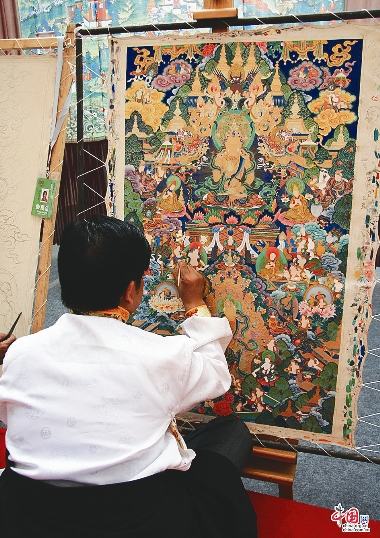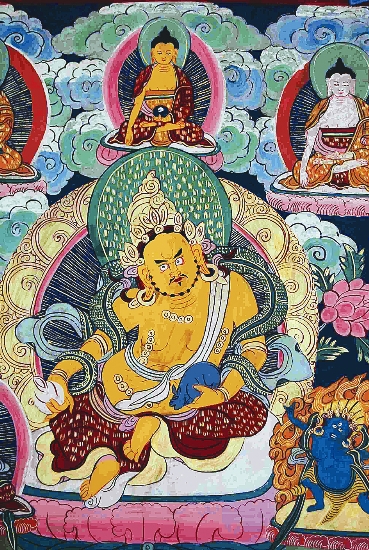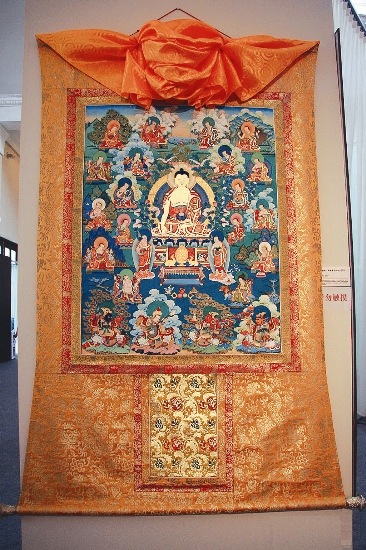|
While the buyers of thangka used to be temples and Buddhists in Qinghai and Tibet, today nouveau riches throughout China compete to purchase the art. Businessmen worship the Yellow Jambhala, the God of Wealth in Tibetan Buddhism. Officials worship Buddha Manjusri, believed to be able to bring power and wisdom.
THE style of houses in the valley of Regong features earthen exterior walls and wooden interior decorations. From the outside, it appears the owners of the houses are as poor as they were three decades ago.
But residents in Regong, Qinghai Province, have become rich beyond their wildest dreams. They make a living making thangka, scroll paintings developed in the 7th century in Qinghai and Tibet.
This painting is made by folk handicraftsmen and holds a sacred place in Tibetans’ hearts. Today the influence of thangka has gone far beyond Tibetans and Buddhists, and artists in Regong are earning a fortune.
In the past, thangka craftsmen did not price their paintings — they donated their works to temples and accepted whatever sums the temples could give, so thangka was not a plausible livelihood. Today a thangka is often priced at more than 100,000 yuan (US$15,736), and is never short of buyers.



While the buyers of thangka used to be temples and Buddhists in Qinghai and Tibet, today nouveau riches throughout China compete to purchase the art. Businessmen worship the Yellow Jambhala, the God of Wealth in Tibetan Buddhism. Officials worship Buddha Manjusri, believed to be able to bring power and wisdom.
In 2008, Regong became the third “State-level culture reserve zone” in China. In 2009, Regong thangka was enlisted as an intangible cultural relic by UNESCO. While most intangible cultural relics face extinction, thangka paintings are experiencing unprecedented popularity, said Professor Gazang Caidan of the Northwest University of Nationalities, who wrote the book “Regong Thangka.”
Xia Wuta, 34, is a thangka artist in Regong. His works have been sold to foreign countries including the United States. He keeps the works he is most proud of in his family hall for worshipping the Buddha. His favorite of his own works is “Eighteen Arahants,” which he spent a year painting. “I added my own understanding of Buddhism to the painting,” he said. For example, the Arahants in his painting wear Tibet-style kasaya instead of Han-style kasaya.
Somebody offered to buy the painting for 500,000 yuan, he refused immediately. “I will never sell this painting, regardless of the price,” said Xia, who began to learn thangka painting at the age of 8. At the age of 13, poverty forced him to quit school and paint full-time.
Xia has 15 disciples. They help the master add colors and set rules. The pigments in thangka are made from rare minerals, including gold, silver and agate, as well as plants such as saffron. Through hand-grinding, the art can keep its colors for hundreds of years. Painting thangka involves many arduous tasks. Even the size of fingers and toes of the figures need to be carefully considered. “You have to strictly follow the rules,” he said.
While traditional thangka artists would paint only one Buddha for their whole career and paint every painting in the same style, Xia likes to try new styles. “I learned from Buddhist scriptures that we should not simply copy past masters in our paintings,” he said. Like all traditional thangka handicraftsmen, Xia is a pious Buddhist. He does not eat meat, and he bathes and prays before starting each painting.
Geng Deng left school at the age of 14. Every spring, he would leave home with his master to paint frescos for temples. Every autumn, he would return home with a salary of less than 1,000 yuan.
“I had thought that I would spend my whole life traveling between temples,” said Geng Deng.
Since 2004, orders for thangka began to mount and he could stay at home painting. Since 2008, the price of thangka has skyrocketed.
When he was a teenager, a good thangka was sold for several hundred yuan. Ten years ago, 3,000 yuan could buy a good thangka. But now a thangka painting of the same quality is priced at more than 1 million yuan, said Geng Deng.
“People paint day and night for 365 days a year. Still we cannot meet the demand,” said Geng Deng.
Geng Deng has eight disciples, including two female disciples. He is the first artist in Regong to teach girls to paint thangka. In the past, only boys were allowed to learn the skill. Geng Deng’s disciples even include two Han boys, who, unlike the Tibetan boys, sit on stools while painting.
To the layman, each thangka painting looks similar. But professionals can tell the quality of Tang-ka paintings at a single glance. An Avalokitesvara has 30 obvious features and 80 trivial features. “With one small mistake, the painting is doomed, even after you have carefully depicted 100 features,” said Geng Deng.
Artist Niang Ben collected nearly 600 masterpieces of senior craftsmen two decades ago. Now each of these paintings is worth more than 1 million yuan. His collections include works by his master, Xiawu Cairang, who painted the piece at the age of 17. “Somebody offered to buy it with 2 million yuan. I did not agree,” said Niang Ben.
The rising prices of thangka have given rise to cheap alternatives. Thangka is being mass-produced with modern printing technologies and cheap chemical pigments.
“The government has set standards for thangka paintings to protect traditional skills from the threat of industrial methods,” said Ma Mingsheng, a government official of Regong.
(Helen Deng)
|

